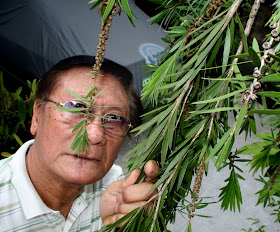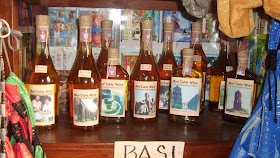Bottle Brush or Weeping Willow Insect repellant and spray, deodorant and ointment
Dr Abe V Rotor
Direct crude extract (ground
fresh leaves) repels mosquitoes and flies. It also serves as fresh deodorant in
the bathroom and kitchen.
Dilute with tap water at 1:4, filter with ordinary cloth, and spray (atomizer) on garden plants and in dark corners.
Bottle Brush or Weeping Willow (Salix sp)
Another preparation is by dissolving the fresh
extract with ethyl alcohol 1:2 ratio, air dry, and add Vaseline or Petroleum
Jelly to the powder residue. This also serves as ointment of minor wounds and skin
problems.
Results of the experiment showed that the extract is effective in repelling house mosquitoes (Culex pipens) with the same efficacy as the advertised commercial product. The result also validates the old practice of using weeping willow to ward mosquitoes by simply rubbing crushed fresh leaves on the skin. (Clemente R, Landan RP Luquinario MI and P Padua, UST 2002)
Dr Abe V Rotor
Living with Nature - School on Blog (avrotor.blogspot.com)
Paaralang Bayan sa Himpapawid (People's School-on-Air)
with Ms Melly C Tenorio
with Ms Melly C Tenorio
738 DZRB AM Band, 8 to 9 Evening Class, Monday to Friday
Author under a willow tree (Salyx sp). UST campus, Manila
The drooping branches though makes a perfect promenade shade and shelter; it is a favorite subject of art and poetry.
At the slightest breeze, the tree "weeps" in whispers, and sways daintily without any apparent effort. Few dare to plant willow by the window - it transforms into a spiritual being to the superstitious, and courts bad luck to the pessimist.
But the willow is an important tree. Where it grows it creates an ambiance of mixed feelings, and to many cultures it is a tree that is much revered - and feared. Overall all, the world is not what it is without the willow - weeping to the sorrowful, hissing and vibrant to the hopeful, romantic to the lover, sacred to the religious, miracle cure to the healer. ----------------------------------------------------------------------------------------
Direct crude extract (ground fresh leaves) repels mosquitoes and flies. It also serves as fresh deodorant in the bathroom and kitchen. Dilute with tap water at 1:4, filter with ordinary cloth, and spray (atomizer) on garden plants and in dark corners. Another preparation is by dissolving the fresh extract with ethyl alcohol 1:2 ratio, air dry, and add Vaseline or Petroleum Jelly to the powder residue. This serves as ointment of minor wounds and skin problems. -----------------------------------------------------------------------------------
The Importance of the willow tree
Medicine -
Medicine -
- The leaves and bark of the willow tree contain Salicin which is metabolized into salicylic acid in the human body.
- Precursor of aspirin.
- Salicin is isolated in crystalline form and formulated as acetylsalicylic acid, a nonsteroidal anti-inflammatory drug.
- Provides temporary relief.
- Ancient remedy for common ailments to the Sumerians, Greeks and Native Americans
- Claimed to be effective in cure of diseases including cancer.
Agriculture - as source of nectar and pollen for bees.
Energy - biomass and biofuel,
Art -
- Charcoal for drawing, wood for sculptures
- Garden features and landscaping
- Pen and ink paintings in China and Japan
Environment -
- Hedges and landscaping
- Land reclamation, soil building and soil reclamation
- Phytoremediation,(bioengineering)
- Slope stabilisation and soil erosion control
- Biofiltration, shelterbelt and windbreak
- Wildlife habitat
Religion -
- Ritual in Jewish holiday of Sukkot, and Buddhism
- Christian churches in northwestern Europe and Ukraine use willow branches in place of palms on Palm Sunday.
- In China, some people carry willow branches on the day of their Tomb Sweeping or Qingming Festival.
- Willow branches are put up on gates and/or front doors, to ward off the evil spirits.
- The Goddess of Mercy Guanyin is shown seated on a rock with a willow branch.
Literature -
- Ancient Korean poem goes, "By the willow in the rain in the evening." The poet Hongrang to her parting lover wrote, "...I will be the willow on your bedside."
- In Japanese tradition, the willow is associated with ghosts. It is popularly supposed that a ghost will appear where a willow grows. Willow trees are also quite prevalent in folklore and myths.
- In English folklore, a willow tree is believed to be quite sinister, capable of uprooting itself and stalking travelers.
- Hans Christian Andersen wrote a story called "Under the Willow Tree" (1853) in which children ask questions of a tree they call "willow-father", paired with another entity called "elder-mother"
- Old Man Willow in J. R. R. Tolkien's legendarium, appearing in The Lord of the Rings.
- "Green Willow" is a Japanese ghost story. Other stories: "The Willow Wife" and "Wisdom of the Willow Tree."
- Remember "The Willow in the Wind?"











































